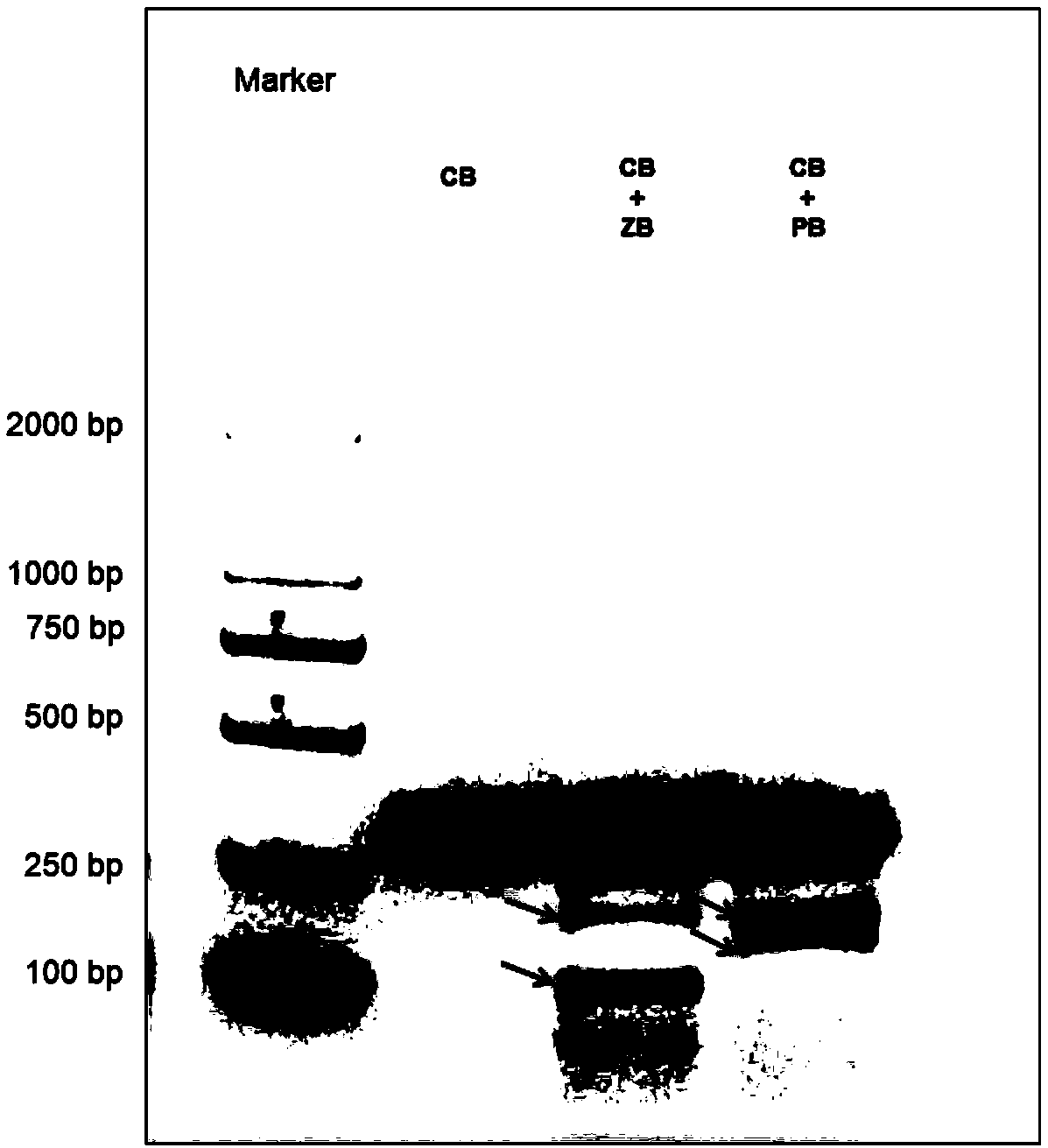Application of bulbus fritillariae cirrhosae ITS1 sequence fragment and detection method of fritillary bulb varieties
A technology of sequence fragments and detection methods, applied in biochemical equipment and methods, measurement/inspection of microorganisms, DNA/RNA fragments, etc., can solve problems such as failure to detect
- Summary
- Abstract
- Description
- Claims
- Application Information
AI Technical Summary
Problems solved by technology
Method used
Image
Examples
Embodiment 1
[0036] The genome extraction of the known Fritillaria sichuanensis and the genome extraction of the samples were carried out separately: two samples were prepared, sample 1 was a mixture of Fritillaria sichuanensis and Fritillaria chinensis, and sample 2 was a mixture of Fritillaria sichuanensis and Fritillaria chinensis;
[0037] Reagents: Lysis solution (L1), DNA extraction solution (E1), buffer solution (W1), rinse solution (W2), DNA eluent (TE solution);
[0038] Proceed as follows:
[0039] 1) Take fresh tissue or dry weight tissue of Fritillaria, add liquid nitrogen to fully grind;
[0040] 2) Quickly transfer the ground powder to a centrifuge tube pre-installed with 65°C preheated lysate L1 (before the experiment, add mercaptoethanol to the preheated L1 to make the final concentration 0.1% by mass), and quickly After inverting and mixing, place the centrifuge tube in a 65°C water bath for 20 minutes, and invert the centrifuge tube during the water bath to mix the sampl...
Embodiment 2
[0051] The genome obtained in Example 1 is subjected to PCR amplification, and the amplification system is as follows:
[0052]
[0053] Dilute to 50 μL with nuclease-free water;
[0054] The PCR amplification reaction program was: pre-denaturation at 95°C for 2 minutes; denaturation at 95°C for 30 s, annealing at 60°C for 30 s, extension at 72°C for 30 s, 32 cycles; final extension at 72°C for 10 min; storage at 4°C;
[0055] The primer pairs used were:
[0056] ITS1-F1: 5'-CGTAACAAGGTTTCCGTAGGTGAA-3'
[0057] ITS1-R1: 5'-GCTACGTTTCTTCATCGAT-3';
[0058] The ITS1 sequence fragment of the PCR product and the ITS1 sequence fragment of the sample to be tested were obtained.
Embodiment 3
[0060] The ITS1 sequence fragments obtained in Example 2 were purified separately, and the steps were as follows:
[0061] 1) Take out Ampure XP beads 30 minutes in advance and place them at room temperature, shake and mix well before use;
[0062] 2) Pipette 90 μL of Ampure XP beads (1.8 times) into the EP tube containing 50 μL of PCR product, mix well by blowing continuously with a pipette 10 times, and incubate at room temperature for 5 minutes;
[0063] 3) Instantaneous centrifugation, put the EP tube on the magnetic stand, let it stand for 2 minutes until the liquid is clear, suck it up with a pipette and discard the supernatant;
[0064] 4) Keep the EP tube fixed on the magnetic stand, add 200 μL of freshly prepared 80% ethanol by mass (to ensure that the ethanol has completely submerged the magnetic beads), and carefully discard the supernatant after standing at room temperature for 30 seconds;
[0065] 5) Repeat step 4) once, and try to blot up the liquid at the botto...
PUM
 Login to View More
Login to View More Abstract
Description
Claims
Application Information
 Login to View More
Login to View More - Generate Ideas
- Intellectual Property
- Life Sciences
- Materials
- Tech Scout
- Unparalleled Data Quality
- Higher Quality Content
- 60% Fewer Hallucinations
Browse by: Latest US Patents, China's latest patents, Technical Efficacy Thesaurus, Application Domain, Technology Topic, Popular Technical Reports.
© 2025 PatSnap. All rights reserved.Legal|Privacy policy|Modern Slavery Act Transparency Statement|Sitemap|About US| Contact US: help@patsnap.com



